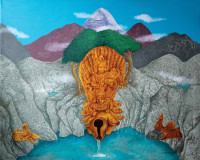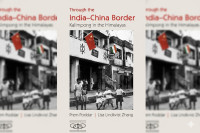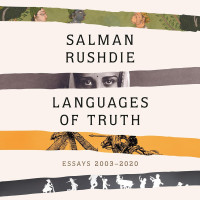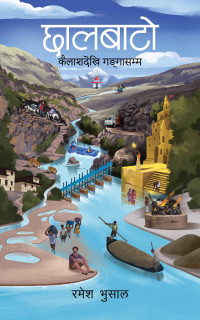Books
Foreign policy fault lines
Nirupama Rao’s ‘The Fractured Himalaya’ is a well-researched authoritative book on strained India-China relations precipitated by Tibetan developments.
Lok Raj Baral
History seldom appreciates political leaders who make crucial decisions in their lives. Most often, the general public refuses to understand the time, circumstances, and context in which those decisions were taken and thus end up looking at those leaders unfavourably.
One such leader is India’s first-ever prime minister, Jawaharlal Nehru (1947-64). Many Indians still hold him responsible for not showing steadfast resistance when communist China decided to annex Tibet in 1950. Nehru's failure to develop a new approach to draw a new boundary line based on a new survey conducted jointly by India and China and his decision to stick to the colonial era McMahon line, which the Chinese rulers had invariably opposed, are the two principal reasons for the ongoing Sino-Indian mistrust and rivalry.
The McMahon line has no validity for the Chinese as it was not jointly demarcated. Sir Henry McMahon was the British representative at the Simla Convention of 1914, in which he had proposed ‘inner’ Tibet and ‘outer’ Tibet. As per the convention, the Chinese could exercise its suzerainty over inner Tibet, while outer Tibet could be autonomous. This is the bone of contention that runs through the entire Tibet-China and India relations.
In her new book ‘The Fractured Himalaya’ (Penguin/Viking, 2021), Nirupama Rao, who served as ambassador to China as well as foreign secretary of the Government of India, has given a detailed analytical account of strained India-China relations since the Chinese annexation of Tibet despite entente cordiale shown outwardly in bilateral relations.
The book can be credited as a well-researched authoritative book on strained China-India relations precipitated by Tibetan developments.
It well articulates how relations between countries can be misconstrued unless the general people don't know the intricacies of relations. Thus, the apparent bonhomie between India and China in the early 1950s was deceptive as the Chinese ambition was neither adequately understood by Prime Minister Nehru nor by his ambassador KM Panikkar. In fact, Nehru had great faith in Panikkar's reports, even though they contrasted the views of other bureaucratic and political elites of the government. In the early part of the book, the running theme is how Panikkar influenced his master despite Chinese “contempt for the Indians, and a sense of very considerable superiority towards them”, observed the British Foreign Office in 1950. It was stated that “the Indian on occasion may be sentimental, but the Chinese is essentially a realist …”.
Sardar Vallabhbhai Patel, in particular, had urged Nehru not to make a hasty decision on endorsing Chinese sovereignty in Tibet. Yet the Chinese interest in Tibet was not an immediate creation as the Chinese rulers had developed a uniform view about Tibet. Even when China was fighting the Japanese during the Second World War, the Chiang Kai-shek regime “could not regard Tibet other than as an integral part of China.” Such a view contradicted that of the Tibetans because the latter considered their country independent. Thus, the Tibetans looked to other powers, especially the British in India, to support the independent status of Tibet. The same approach continued after India’s independence even when the new regime in Delhi headed by Nehru seemed to pursue a dual policy with continuing the traditional strategy for recognising old Tibet policy.
Rao believes that India’s approach was “faulted for its excessive circumspection, caution bordering on timidity, and the suspension of disbelief about Communist China and its policies on strategic peripheries like Tibet and Xinjiang.” The author thinks that India “acquiesced in being shortchanged and where could have led a global initiative questioning China’s Tibet policy. In fact, India preferred the path of renunciation and calculated indifference.”
In 1954, India put a stamp on Chinese claims, giving up its stand on the ‘autonomy of Tibet’ and subsequently restricting “all her actions in support of Tibet.” High-ranking security experts observed that China “had conceded almost nothing to India.”
However, Nehru’s approach towards China continued to be ambivalent, thus gradually giving grounds to Chinese activities in Tibet. This is why the 1954 agreement was “regarded as a masterstroke of Chinese diplomacy and Zhao Enlai (Chinese Prime Minister) as ‘perhaps the most notable diplomatic conjurer since Bismarck’.
The erudite diplomat Nirupama Rao writes “the best foreign policy is a combination of firmness and flexibility… firmness, without strength, cannot fulfil its desired aims.”
Indian policy since the flight of Dalai Lama in 1959 has been marked by firmness in words without support of strength and clarity as diplomacy “foundered in a whirlpool of political rhetoric…”
Based on authoritative evidence and major dramatis personae, the book has extensive details on Tibet-China relations and mutual perceptions relating them to triangular interpretations. Tibet, which perennially aspired for its own identity and existence, was the greatest loser amid the cross-fires of rivalries of the two emerging powers, China and India.
In the concluding part of the book (Coda), Rao has tried to revisit the complexity of India-China relations, particularly triggered by recurrent border disputes. Suspicion and distrust are on the ascendancy, and this has driven India to seek new supporters in case Chinese arrogance leads to larger conflicts between the two nations.
Like Nehru, Narendra Modi is also humiliated when his hobnobbing and bonhomie with Chinese President Xi Jinping could not help change the existing conflict-torn relationship.
On the contrary, Modi’s 18th meeting with Xi threw both the countries into border conflicts in both eastern and western sectors. Engaged in ‘combative coexistence’, the phenomenon of rival powers is likely to continue both on the border and strategic front.
Rao remarks that “Xi Jinping’s global ambitions exceed those of Mao Zedong and Zhao Enlai and that China today is the flag-bearer of a new imperium in Asia.” Whether or not China's march towards greatness is going to help change world politics into cooperative and peaceful rule-based order, it is imperative on the part of both China and India to settle the existing border disputes with some sort of a quid pro quo.
And, Rao suggests a political solution that may help India and China ‘re-fashion’ their claims. But how such a solution will be found is not yet clear.
Rao has developed a good narrative of Chinese attitude towards India as the former had developed a sense of disenchantment with Nehru as the leader of non-aligned nations.
—————————————————————
The Fractured Himalaya
Author: Nirupama Rao
Publisher: Penguin/Viking, 2021
Pages: 512




 18.12°C Kathmandu
18.12°C Kathmandu










